#i will be drawing more homosexual wrestling if you all are interested in seeing more
Text
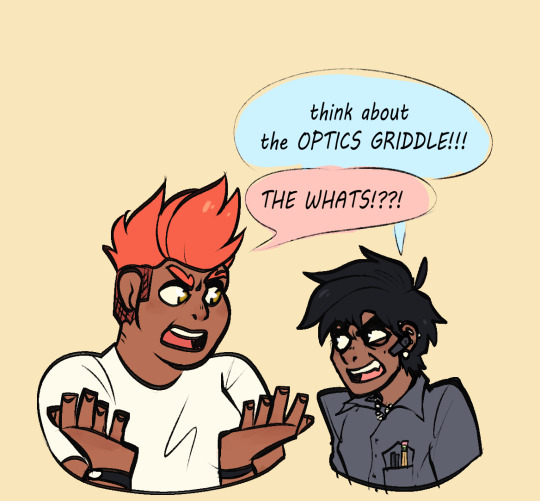

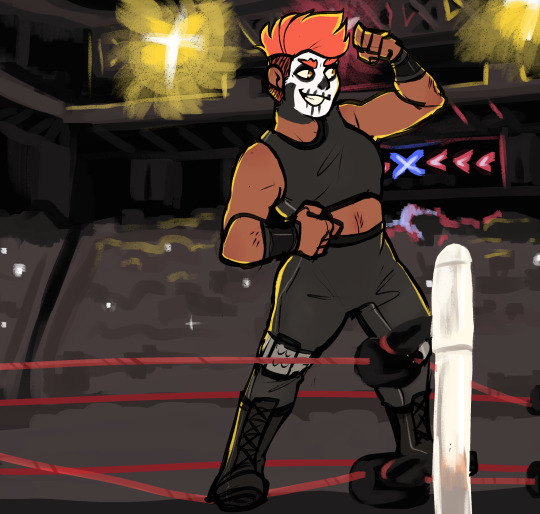

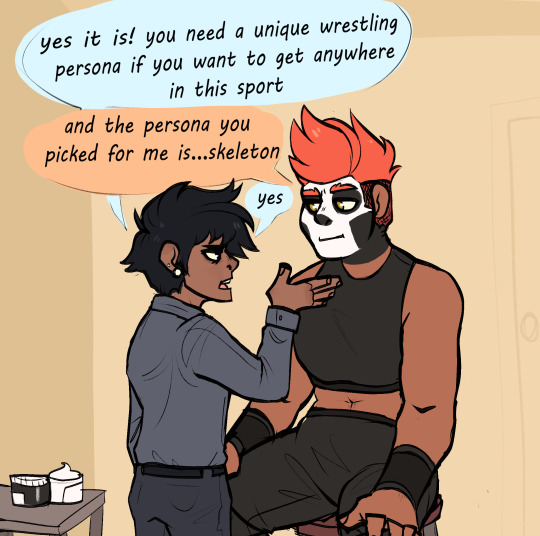




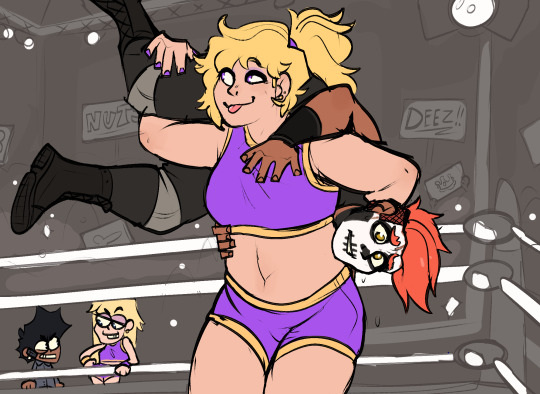
hello guys it's me miss consistent art style!!! wrestling AU????? sorry i am smashing my 2 current interests together as ya do, gideons trying to be a cool pro wrestler and harrow is her manager
#tlt#griddlehark#the locked tomb#gideon the ninth#harrowhark nonagesimus#gideon nav#camilla hect#ianthe tridentarius#idk im not tagging ALL of them you know the guys#i been watching a lotta wwe and wow lately good shit lemme tell you what#i need somebody to like wrestling like i do so i can yell at them about WOW like please that shit is CRAZY#anyways i have so many ideas for this AU you have no idea#i have plans for most characters okay it all fits perfectly just give me another 100 pages to tell you about it#i will be drawing more homosexual wrestling if you all are interested in seeing more#i love being cringe smiles real big
1K notes
·
View notes
Text
Fun read. His case is strong, very strong!
I'm down for a Man from UNCLE sequel!

Jan 7 2019
I’m not sure how everyone missed this when it came out in 2015 but the queer energy that this movie puts out is intoxicating.
Guy Ritchie’s 2015 retro spy flick The Man from U.N.C.L.E. is a fantastic and fundamentally bisexual movie, and I will die on this hill.
As a bisexual cinephile, I find myself queering most films I watch. Unless and until I’m told otherwise, all movie characters are bi. Still, some movies stand apart. Not because they explicitly embrace queerness, but because they feel queer on some deeper level. They exhibit queer themes, queer aesthetics, queer politics. They lend themselves to queering by the audience (...)
The Man from U.N.C.L.E. is one such queerable film. A remake of the 1964 series of the same name (which itself didn’t exactly scream "straight"), the film exudes bisexual energy at every turn, both narratively and in the chemistry, between not only its three protagonists but virtually everyone they come into contact with.
To be abundantly clear, I know the characters weren’t written bi. I know there’s nothing explicit in the film. (...)
U.N.C.L.E. opens in 1963. Suave CIA agent Napoleon Solo (a dapper Henry Cavill effortlessly channeling James Bond) is on an extraction mission in East Berlin. He’s looking for fast-talking car mechanic Gaby Teller (Alicia Vikander), whose former Nazi scientist father may be helping a group of international terrorists build a nuclear weapon. Hot on their tail is no-nonsense KGB agent Ilya Kuryakin, played by tall, broody, square-jawed Armie Hammer. Soon the two spies are tasked with working together to find and stop Teller, with Gaby along for the ride and more or less on their side.
The plot doesn’t really matter though. The pleasures of The Man from U.N.C.L.E.—and there are many—come down to the quick repartee, charming flirtation, gorgeous mise-en-scène, and constant turning of tables, where any back can be stabbed by anyone at any time.
The actors deserve a lot of credit for how bisexual this whole endeavor is. The three protagonists bicker to no end, and while Ilya and Gaby’s playful fighting (sometimes literal wrestling) does explicitly lead to and connote romance, Ilya and Solo exhibit an almost identical tension (wrestling included) that seems hardly limited to the bromance the filmmakers might have intended. Solo and Ilya are jealous of each other’s love interests when they’re not comparing gear and bugging each other’s rooms (the double entendres are hard to keep up with). Add in the overt flirtation between Solo and Gaby when they have their own meet cute, and you have a rather perfect love triangle between the three.
The villains get in on the action too, each as universally flirtatious as the next. (....)
In hindsight, casting doesn’t hurt either. U.N.C.L.E. stars queer ally Armie Hammer. Hammer played down his onscreen kiss with Leonardo DiCaprio in 2011‘s J. Edgar as a normal part of acting, and was visibly and physically affectionate with his co-star Tomothée Chalamet during promotion of their queer coming of age hit Call Me By Your Name in 2017. Accusations of self-satisfied queer-baiting are not unreasonable, but for what it’s worth, Hammer’s enthusiastic allyship has always come off as entirely sincere to me.
Beyond Hammer, the entire cast is just absurdly good looking to the point of distraction. It’s not just that any pairing could work, it’s that they all seem so darn appealing—I can only assume the film itself left more than a few impressionable viewers with questions about their own chaotic scattershot of attractions.
I’m not alone in my thinking. I’ve found ample common ground when bringing this film up with bisexual friends. The world of fan fiction, well known for queering pop culture, has also embraced U.N.C.L.E. As I write this, popular fan fic database Archive of Our Own lists 2,702 works of Man from U.N.C.L.E. fic. For comparison’s sake, 2013’s Man of Steel has just 543 entries, and the whole Die Hard franchise has 623.
Even a handful of film critics could see, if not the full bisexual potential of U.N.C.L.E., at least some hints of homoeroticism. None really followed the queer breadcrumbs all the way to any satisfying conclusions though.
In one particularly dismissive review from Wired, Daniel Smith suggests that any homoeroticism applied after the fact should be disregarded. The question “are they gay?” Is irrelevant. Instead, men—straight men, presumably—should be inspired to emulate the warm camaraderie of Solo and Ilya as some kind of model for healthier masculinity, says Smith.
Please!
What a cop out, and what a heteronormative view of male bonding. Healthier masculinity is a noble pursuit, no doubt, but why should it come at the expense of attraction between men? Non-straight men aren’t magically exempt from toxic masculinity, and our experiences shouldn’t be passed over in the name of educating straight dudes.
But there’s more to it than that. The dismissal of the hints of attraction between Solo and Ilya (who also both display attraction to many women) leads critics to pass over U.N.C.L.E.’s fundamentally bisexual—rather than gay—themes.
The whole premise is one big Kinseyian metaphor. Alfred Kinsey famously established the concept of the Kinsey scale, whereby human sexuality exists on a spectrum. Your sexual orientation can be measured from zero (exclusively heterosexual) to six (exclusively homosexual). It’s a relatively blunt instrument for measuring sexual attraction, but it gets at the basic notion that sexual attraction exists on a spectrum rather than being binary
Our two Greek God-inspired super spies similarly find themselves somewhere between two polar extremes when they decide to collaborate for the greater good (the expression “playing for both teams” comes to mind).
The basic Cold War tension between East and West is extremely binary in nature. The film’s opening credits graphically illustrate this by drawing straight, hard lines on animated maps between East Berlin and West Berlin. But the entire narrative undoes this division by bringing the CIA and KGB together in a murky space somewhere in between American and Soviet politics.
In one early scene, we see Solo zip lining across the border between East Berlin and West Berlin. When Ilya attempts to follow, Solo lowers the wire, and the Soviet spy is caught right in the middle of the two extremities. It’s a beautiful bit of imagery that sums up my entire argument. This is a film so conspicuously invested in exploring the middle ground of things that it thematically lays the groundwork for queering its characters.
One can only hope that a more overtly queer sequel might one day grace our theater screens. Or a moreexplicitly queer sequel. Solo and Ilya are paired up by their superiors as they tussle in a men’s room, for God’s sake. The messaging is clear, just not stated in so many words.
Rumors of a sequel have circulated for years, but unfortunately U.N.C.L.E. wasn’t a huge hit at the box office, despite how incredibly fun the damn thing is. One potential explanation for its failure is that 2015 was a pretty crowded year for 60s spy nostalgia, and it had to compete with the latest entries in the more well-established Mission: Impossible and James Bondfranchises.
Nevertheless, Hammer has pointed to the film as one of the roles he’s most often asked about by fans, and he once even suggested he’d talked screenwriter Lionel Wigram into starting on a sequel. I’m still skeptical, as nothing definitive has been announced yet.
For now, I’ll hold on to what we have and cherish The Man from U.N.C.L.E. as a resounding bisexual anthem. Anyone who refuses see it as such is frankly missing out on some of the film’s most rewarding features.
In short, it’s ours and we’re keeping it.
#armie hammer#cmbyn#call me by your name#on the basis of sex#onthebasisofsex#felicity jones#the man from uncle#man from uncle#tmfu#guy ritchie#henry cavill#alicia vikander#elizabeth debicki#solo#ilya kuryakin#queer#queer eye#queer film#queer fiction#biseuxal#012019
7 notes
·
View notes
Text
The Untameable by Guillermo Arriaga

The Untameable
By Guillermo Arriaga
Translated by Frank Wynne & Jesse Mendez Sayer
MacLehose Press, Quercus
Guillermo Arriaga is a Mexican author, screenwriter, director and producer whose previous books have been translated into 18 languages. I awaited the release of The Untameable with high anticipation as it is Arriaga's first novel since he rose to prominence as a screenwriter on the Oscar nominated Babel, 21 Grams and the BAFTA winning Amores Perros. Seeing the latter movie upon its release really was my first insight into Mexican life; the clever interplay between three different story lines which are brought together by a car crash remained very vivid for me. By chance I actually re-watched Amores Perros shortly before hearing of this book.

The Untameable is an epic read which clocks in at just over 700 pages and alternates between two storylines. The primary focus is upon teenager Juan Guillermo who lives within one of the lower middle class barrios of Mexico City in the 1960s. The second is the tale of an Inuktitut hunter named Amaruq who starts tracking a wolf in Yukon in the far north west of Canada in an initially undeterminable time. The book also features a series of short passages relating to various historic events and folk stories from around the world the purpose of which later become clear to the reader.
The English translation of The Untameable has been completed primarily by esteemed translator Frank Wynne who has translated many outstanding works from Spanish and French. These include The Blue Hour by Alonso Cueto (shortlisted for the 2013 Oxford-Weidenfeld Translation Prize), The Siege by Arturo Pérez-Reverte and all translated titles by Pierre Lamaitre. As is the case for those novels the translation is flawless and the language always fresh. Arriaga’s talants as a screen writer enhance his storytelling which is vividly told, leaving a very strong impression of the key characters and their surroundings
Juan is the first person narrator of his part of the story and we join him at the age of 13 during a hot Mexican summer living at home with his family. This consists of his parents, grandmother, elder brother of 6 years Carlos and their pets, a brindle boxer called King and their Australian parakeets Whisky and Vodka. No sooner do we have a chance to visualise his family setting, than we are ominously informed that he will the only one to remain alive over the next 4 years. Tragically the first to go will be Carlos who we learn will be murdered.
The Untameable is marketed as a coming of age novel which is partly true but it is also so much more. There is an obvious crime, in fact multiple crimes, it’s part a historic novel, part romance and it’s also a tale of long awaited revenge. From the storylines in Yukon it is also a travel adventure. Little wonder that renowned Colombian writer Santiago Gamboa calls The Untameable one of the best books he has read. Juan’s story is always absorbing as it builds to the details that scarred him most, his desire for retribution and atone for his own regrets while the story from Yukon gradually evolves bringing new components to the book which only link at the conclusion.

Juan tells us his story on a mainly reflective basis. We learn how his life was saved through blood transfusions and about his experiences at a private school which his parents could barely pay for. An early injustice he faced is when he is expelled yet a wealthier child is not. It is just the start of an examination of the inequality and misfortune that will tarnish the experiences of Juan and the lives of his family. His older brother Carlos is the most enterprising family member in tough economic conditions. Having received a chinchilla as a birthday present starts to breed them for their fur. There could be scenes that some readers may find upsetting in respect of the treatment of the chinchillas and local stray cats, also in Canada where some animals are trapped. However I would state that these are not intentionally graphic. I interpret these being shown as part of methods to develop and preserve the protagonists livelihood rather than to needlessly harm. The brothers have refused requests to put their dog into dog fighting for financial gain so there are no scenes like viewers may recall from in Amores Perros.
A lot of the interaction with neighbours comes from the boys moving from rooftop to rooftop. While Juan and many of the other local boys were raised without a strong religious faith, another group known as “The Good Boys” follow their twisted interpretation of the bible. Led by Humberto they try to recruit other younger boys and preach to Juan and his friends for a while. Our narrator realises the contradictory nature of their beliefs:
"On the one hand everything that happened was the result of Divine Will: “God willed it so” on the other hand the Devil was lurking everywhere, waiting for the opportunity to tempt Man and lead him from the path of righteousness.”
Effectively this group are “an army in training”, fundamentalists who with the consent of the local priest dispatch punishment to those who are Jewish, Communist or are believed to carry out immoral behaviours such as homosexuality. They attempt to draw Juan and his friends into what is effectively a clandestine death squad. Juan is in denial of their true harm at first as he is far more interested in his discoveries of William Faulkner, Jimi Hendrix and his first regular sexual experiences.
We also learn of the corrupt policeman Zurita. The captain is more concerned with getting a cut from illegal activities than stopping them. As Carlos’ businesses expands into other areas and he continually refuses to cooperate with Zurita, his enterprise eventually makes him a target for The Good Boys. Before we learning of the events that are to unfold Juan uses biblical images to describe how his life is about to change: “then came the plaque of destruction, and the locusts of death devoured everything in their path.”
While Carlos is trying to keep ahead of his enemies by monitoring unknown cars and finding regular hiding places, there is also a battle of wits on the Canadian tundra between Amaruq and a giant grey wolf he calls Nujuaqtutuq. The beast is luring him further northwards where the chances of both finding food are slimmer. Amaruq is under a belief this particular animal is one his grandfather warned him about:
"Of all the wolves you will see in your life, one alone will be your master.”
The descriptions of the landscape in the Canadian scenes are as detailed of those in Mexico City so that you can virtually visualize them. This is a key feature of this book, the details of the settings are always vividly relayed without detracting from the narrative of the story.
The strength of the characterisations particularly mark this book for distinction. Juan sustains our support as the main protagonist throughout his troubles. His grief for the accumulated loss of family members is palpable and his reactions feel realistic. There are very lifelike stumbling blocks at the start of his romance with the once promiscuous Chelo as they borh try to adapt to the terrible circumstances that life has thrown at him. He receives a sympathetic role model after meeting Alives as they both belong to the “community of orphans.” Juan is protective of the family pets and even adopts the fearsome Colmillo who could not be tamed by his owners. Humberto is almost Juan’s polar opposite but there is enough given about his own background to develop him as a convincing character. In this barrio in late 1960s Mexico City it is those that portray themselves as good are those who carry out the most evil of acts. We see Juan wrestles with his conscience and desire for a settled life with Chelo against his determination to exact revenge; knowing that there will be consequences for him. He would be breaking an unwritten rule: “victims could not be aggressors, and if they did, they were declaring war.”
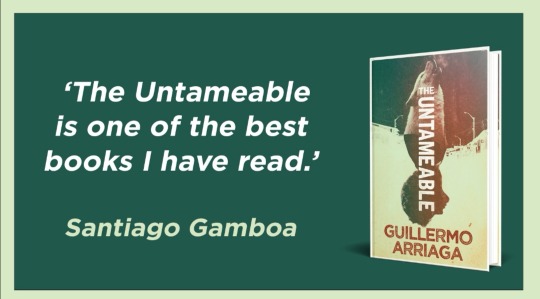
The Untameable is an exceptional novel. It addresses sudden bereavements and attempts at reconciling these during adolescence, it tackles themes of societal inequality and corruption, the complete lack of morality in some locally organised religious groups and more widely the concept of vengeance. It is a fascinating tale with contrasting textures, writing styles and literary references. Its length should not be a deterrence due to the multiple storylines, timeframes and themes within the story. If any of these intrigue you then I would urge you to read The Untameable. Ultimately this is a captivating chronical of one brave boy’s struggles against almost unsurmountable challenges which will hook you in, immerse and captivate you right until the end.
0 notes
Note
Since its valentines, I was looking up "the bible on same sex marriages." I found a verse that I hadn't seen before, 1 Corinthians 6:9-10. And nowwwww in shook and scared and panicking bc I just, my confidence in my faith and sexuality is so fragile and I just need help understanding this.
Hey there! Rest easy, anon. It’s okay to feel shaken by something you hadn’t seen before in Scripture – it’s also okay to wrestle with it. God invites us into conversation with the Bible – so let’s gather some facts that will allow us to converse.
(Here are the two verses from 1 Cor 6, for those who want to see them: “Do you not know that wrongdoers will not inherit the kingdom of God? Do not be deceived! Fornicators, idolaters, adulterers, male prostitutes, sodomites, thieves, the greedy, drunkards, revilers, robbers—none of these will inherit the kingdom of God.”)
For this particular passage, the issue of translation actually comes into play, along with issues of cultural context. See this post for an overview of all the “clobber claim” passages used against LGBT folks; and especially see page 11 of my research paper from a few years ago, where I go in depth about the translation issues. …Actually, I’ll go ahead and paste my paper’s whole conversation on 1 Corinthians 6:9-10 (as well as 1 Timothy 1:10) right here for easy access:
~ 1 Corinthians 6:9 and 1 Timothy 1:10. Two other verses in the New Testament letters are frequently interpreted as condemnations of homosexuality because of the standard ways that two ambiguous Greek words, malakoi and arsenokoitai, are translated.
The first of these words, malakoi, is used in 1 Corinthians 6:9. While modern translators usually render it “men who practice homosexuality” or “homosexuals,” it more literally means “soft,” and “it appears elsewhere in the New Testament to describe fine clothing (see Matthew 11:8). In a moral context, the term was used to describe a lack of self-control, weakness, laziness, or cowardice. …The word was an all-purpose insult for anything considered to be feminine” (Vines, 2014, p. 119). Vines goes on to note that in Greco-Roman culture this term more often referred to men who “succumbed to the charms of women,” since doting excessively on a woman—fixating too much on the romantic aspects of a relationship or allowing a female lover to influence one’s decisions—was considered unmanly (p. 120). Thus, he explains, malakoi is generally translated in older versions of the Bible as “effeminate” rather than “homosexual” (p. 122). With all of this in mind, perhaps a more fitting translation would be something like “those who demonstrate weakness” or, to keep the meaning as broad as the original term, “those demonstrating soft qualities.”
Arsenokoitai, used in both 1 Corinthians 6:9 and 1 Timothy 1:10, is even more difficult to translate accurately, as it appears very infrequently in Greek writings (Vines, 2014, p.122). The word may, in fact, have been coined by Paul, and is a compound word combining arsen, “male,” and koites, the term for “bed” most often used when a sexual connotation is intended. Thus, the usual interpretation of this word is “men who sleep with other men” (p. 123). However, Vines relates, the few examples of this word that can be found in later Greek texts “indicate it most often referred to economic exploitation, not same-sex behavior” (p. 124). Vines provides evidence from three texts on pages 124 and 125 of his book, which are worth reviewing in full.
It is interesting to note some of the most common translations of arsenokoitai: along with “homosexuals” and “perverts,” the word “sodomites” is often used. Drawing back to the earlier discussion of Sodom, the choice to use this term here for a word that in its original form clearly shares no root with the word “Sodom” unfairly influences a reader’s perspective of the sin of Sodom. If a Bible uses the word “Sodomite” to mean a male practitioner of same-sex acts, the reader is influenced to interpret Sodom’s annihilation-worthy crime as being homosexuality, before they have the chance to consider for themselves whether that is necessarily the case. On that note, this paper will turn to its final discussion, that of linguistic methods employed by some Christians to influence biblical interpretations. ~
End of paper passage.
Now, even if there is a solid argument to translating these terms as “homosexual” etc., cultural context can and should be taken into account by any responsible and reverent reader of the Bible. After all, we read other areas of the NT letters that appear to condone slavery in light of their ancient context. See this post (linked above as well) for some discussions on interpreting Scripture while keeping context in mind.
I also recommend Austen Hartke’s short video “Are you taking the Bible seriously?” Wander through our interpretation tag (particularly this post) for even more information. Peace
#1 Corinthians 6#1 Corinthians 6:9#clobber claims#rebuttals#but what does the Bible say?#bible tag#affirmation#anon#queerly christian asks#interpretation#homophobia
108 notes
·
View notes
Text
Political Histories *gay edition*: So Let’s Talk About the Romans
For some reason when I think of ancient Greek and Roman culture my mind immediately drifts to naked bicurious men wrestling in the ancient Olympics, or of rulers with many wives and husbands alike. This isn't entirely accurate, but there are a few interesting similarities. Nero and Trajan were two prominent Roman emperors at the beginning of the common era. Both men were known for their homosexuality, with Nero marrying two men in official ceremonies and Trajan now being known throughout history for his fondness of his male counterparts. The farther in history you go, the less you see when it comes to queer figures and documentation. Not only do you see less but much more of it is negative. Around the year 1532, the Holy Roman Empire makes sodomy and consensual gay sex illegal and punishable by death. Not the first and certainly not the last. During this time governments all across the globe adopted similar policies. In other places, queer people were in lots of different situations. At this same time, Michelangelo was beginning a series of hundreds of drawings and poems for his presumed gay lover, Tommaso de’ Cavalieri. In the 500s, the world gained, as they are now referred to today, its first ‘transgender saint’, a person born as a woman who lived over 28 years of their life as a male monk in Egypt. In the 1500s, documentation on the Native American tribes shows their interesting different lifestyles when it came to gender and the special relationship between sex and purpose in society. And in the later 1700s, a few countries that had previously used capital punishment or mutilation on queer people began to decriminalize acts like sodomy. Even with all of that it still rings true that the closer you get to the present the more brutal and severe are the acts against homosexuality and the less you hear of queer pride and celebration.
3 notes
·
View notes